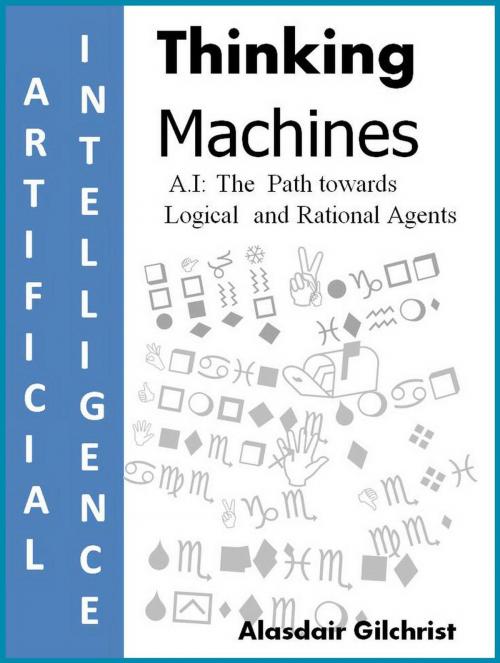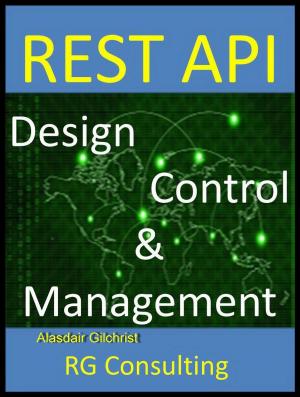A.I: The Path towards Logical and Rational Agents
Thinking Machines
Business & Finance, Industries & Professions, Insurance, Nonfiction, Science & Nature, Technology, Engineering, Industries| Author: | alasdair gilchrist | ISBN: | 9781386555339 |
| Publisher: | alasdair gilchrist | Publication: | July 11, 2017 |
| Imprint: | Language: | English |
| Author: | alasdair gilchrist |
| ISBN: | 9781386555339 |
| Publisher: | alasdair gilchrist |
| Publication: | July 11, 2017 |
| Imprint: | |
| Language: | English |
* *This book is an introduction to the fundamentals of Artificial Intelligence its aim is to introduce A.I. through its history, its contemporary role in society and the economy. We then lift the hood to see how A.I. works and how we can create our very own rational A.I. agents
The topics of interest are as follows:
- A.I. today in 2017
- A.I role in society
- A.I. role in employment
- A.I. role in the economy
- Algorithms and types of A.I
- Modern Approaches to A.I
- What A.I. can do
- What A.I. can't do – for now
- Types of A.I. agents
- Understanding Environments
- Solving Problems with A.I
- Planning with A.I
- Building Rational and Logical Agents
- Applying A.I. through Bayesian and Decision Networks
In early chapters of this book we will learn how AI has reemerged over the last couple of decades due to a rise in complimentary enabler technologies and some surprising successes that have brought A.I. to the mainstream media’s attention.
Then we lift the hood to start our investigations into how AI systems work. We will learn that AI is powered by algorithms, which do the underlying heavy lifting but we will also get an understanding regards how the algorithms achieve their goals and we will glimpse the principles on which they are designed to function. For example, we will learn the importance as to whether an algorithm acts humanly or rationally
Also we will introduce the concept and learn about AI agents what they are and how they relate to artificial intelligence as a technology. We will consider how we make agents intelligent and by what means. We will then consider and learn about the various types of AI agents and have a look at their individual architecture and learn more about each of their functions and purpose. Hence we will learn how to build reflex-based, model-based, goal-based, and utility-based agents by learning how they work. Finally we will introduce learning agents and a radical view of an alternative architecture based upon natures evolutional model.
We will address how to use AI algorithms to solve problems. Hence we will learn how to construct our problem, by ensuring it is well-defined. We will also learn how a search tree works and its infrastructure and how to decompose a search algorithm to its four functional components. We will also learn how to understand the algorithm search performance and results by completeness, optimality, and space and time complexity.
Then we will learn about knowledge-based agents, what they are, how they are built and how we imbue them with knowledge. Furthermore we will introduce and learn about Logical agents where we use representations based on logic statements to allow the agent to perform acts of reason.
In addition we look at AI's role in Planning and why we require AI as a planning agent. We will see how a planning agent's infrastructure differs from problem solving agents in state, goals and actions. Furthermore we will learn the theory behind Bayesian networks and Conditional Probability Tables and how to build them and calculate probability. We will also learn how to use inference algorithms in Bayesian network.
Finally we look at the principles behind rational agents and the 6 constraints known as the Axioms of Utility Theory that any preference model must consider when behaving rationally. Using the knowledge accrued over the previous chapters we will construct a decision network and learn how to use it to derive probabilities of events and calculate maximum expected utility (MEU).
* *This book is an introduction to the fundamentals of Artificial Intelligence its aim is to introduce A.I. through its history, its contemporary role in society and the economy. We then lift the hood to see how A.I. works and how we can create our very own rational A.I. agents
The topics of interest are as follows:
- A.I. today in 2017
- A.I role in society
- A.I. role in employment
- A.I. role in the economy
- Algorithms and types of A.I
- Modern Approaches to A.I
- What A.I. can do
- What A.I. can't do – for now
- Types of A.I. agents
- Understanding Environments
- Solving Problems with A.I
- Planning with A.I
- Building Rational and Logical Agents
- Applying A.I. through Bayesian and Decision Networks
In early chapters of this book we will learn how AI has reemerged over the last couple of decades due to a rise in complimentary enabler technologies and some surprising successes that have brought A.I. to the mainstream media’s attention.
Then we lift the hood to start our investigations into how AI systems work. We will learn that AI is powered by algorithms, which do the underlying heavy lifting but we will also get an understanding regards how the algorithms achieve their goals and we will glimpse the principles on which they are designed to function. For example, we will learn the importance as to whether an algorithm acts humanly or rationally
Also we will introduce the concept and learn about AI agents what they are and how they relate to artificial intelligence as a technology. We will consider how we make agents intelligent and by what means. We will then consider and learn about the various types of AI agents and have a look at their individual architecture and learn more about each of their functions and purpose. Hence we will learn how to build reflex-based, model-based, goal-based, and utility-based agents by learning how they work. Finally we will introduce learning agents and a radical view of an alternative architecture based upon natures evolutional model.
We will address how to use AI algorithms to solve problems. Hence we will learn how to construct our problem, by ensuring it is well-defined. We will also learn how a search tree works and its infrastructure and how to decompose a search algorithm to its four functional components. We will also learn how to understand the algorithm search performance and results by completeness, optimality, and space and time complexity.
Then we will learn about knowledge-based agents, what they are, how they are built and how we imbue them with knowledge. Furthermore we will introduce and learn about Logical agents where we use representations based on logic statements to allow the agent to perform acts of reason.
In addition we look at AI's role in Planning and why we require AI as a planning agent. We will see how a planning agent's infrastructure differs from problem solving agents in state, goals and actions. Furthermore we will learn the theory behind Bayesian networks and Conditional Probability Tables and how to build them and calculate probability. We will also learn how to use inference algorithms in Bayesian network.
Finally we look at the principles behind rational agents and the 6 constraints known as the Axioms of Utility Theory that any preference model must consider when behaving rationally. Using the knowledge accrued over the previous chapters we will construct a decision network and learn how to use it to derive probabilities of events and calculate maximum expected utility (MEU).















